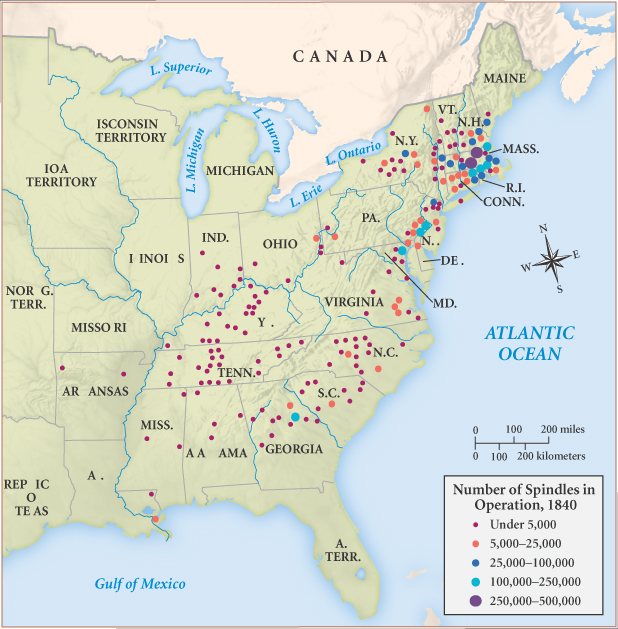America’s History: Printed Page 287
America: A Concise History: Printed Page 261
America’s History: Value Edition: Printed Page 253
The Textile Industry and British Competition
To protect the British textile industry from American competition, the British government prohibited the export of textile machinery and the emigration of mechanics (skilled craftsmen who invented and improved tools for industry). Lured by the prospect of higher wages, though, thousands of British mechanics disguised themselves as laborers and sailed to the United States. By 1812, at least three hundred British mechanics worked in the Philadelphia area alone.
Samuel Slater, the most important émigré mechanic, came to America in 1789 after working for Richard Arkwright, who had invented the most advanced British machinery for spinning cotton. A year later, Slater reproduced Arkwright’s innovations in merchant Moses Brown’s cotton mill in Providence, Rhode Island.

In competing with British mills, American manufacturers had the advantage of an abundance of natural resources. The nation’s farmers produced huge amounts of cotton and wool, and the fast-flowing rivers that cascaded down from the Appalachian foothills to the Atlantic coastal plain provided a cheap source of energy. From Massachusetts to Delaware, these waterways were soon lined with industrial villages and textile mills as large as 150 feet long, 40 feet wide, and four stories high (Map 9.1).
American and British Advantages Still, British producers easily undersold their American competitors. Thanks to cheap transatlantic shipping and low interest rates in Britain, they could import raw cotton from the United States, manufacture it into cloth, and sell it in America at a bargain price. (As they did in India; see America Compared.) The most important British advantage was cheap labor: Britain had a larger population — about 12.6 million in 1810 compared to 7.3 million Americans — and thousands of landless laborers prepared to accept low-paying factory jobs. To offset these advantages, American entrepreneurs relied on help from the federal government: in 1816, 1824, and 1828, Congress passed tariff bills that taxed imported cotton and woolen cloth. However, in the 1830s, Congress reduced tariffs because southern planters, western farmers, and urban consumers demanded inexpensive imports.
Better Machines, Cheaper Workers American producers used two other strategies to compete with their British rivals. First, they improved on British technology. In 1811, Francis Cabot Lowell, a wealthy Boston merchant, toured British textile mills, secretly making detailed drawings of their power machinery. Paul Moody, an experienced American mechanic, then copied the machines and improved their design. In 1814, Lowell joined with merchants Nathan Appleton and Patrick Tracy Jackson to form the Boston Manufacturing Company. Having raised the staggering sum of $400,000, they built a textile plant in Waltham, Massachusetts — the first American factory to perform all clothmaking operations under one roof. Thanks to Moody’s improvements, Waltham’s power looms operated at higher speeds than British looms and needed fewer workers.
The second strategy was to tap a cheaper source of labor. In the 1820s, the Boston Manufacturing Company recruited thousands of young women from farm families, providing them with rooms in boardinghouses and with evening lectures and other cultural activities. To reassure parents about their daughters’ moral welfare, the mill owners enforced strict curfews, prohibited alcoholic beverages, and required regular church attendance. At Lowell (1822), Chicopee (1823), and other sites in Massachusetts and New Hampshire, the company built new factories that used this labor system, known as the Waltham-Lowell System.
By the early 1830s, more than 40,000 New England women were working in textile mills. As an observer noted, the wages were “more than could be obtained by the hitherto ordinary occupation of housework,” the living conditions were better than those in crowded farmhouses, and the women had greater independence. Lucy Larcom became a Lowell textile operative at age eleven to avoid being “a trouble or burden or expense” to her widowed mother. Other women operatives used wages to pay off their father’s farm mortgages, send brothers to school, or accumulate a marriage dowry for themselves.

|
To see a longer excerpt of the Lucy Larcom document, along with other primary sources from this period, see Sources for America’s History. |
Some operatives just had a good time. Susan Brown, who worked as a Lowell weaver for eight months, spent half her earnings on food and lodging and the rest on plays, concerts, lectures, and a two-day excursion to Boston. Like most textile workers, Brown soon tired of the rigors of factory work and the never-ceasing clatter of the machinery, which ran twelve hours a day, six days a week. After she quit, she lived at home for a time and then moved to another mill. Whatever the hardships, waged work gave young women a sense of freedom. “Don’t I feel independent!” a woman mill worker wrote to her sister. “The thought that I am living on no one is a happy one indeed to me.” The owners of the Boston Manufacturing Company were even happier. By combining tariff protection with improved technology and cheap female labor, they could undersell their British rivals. Their textiles were also cheaper than those made in New York and Pennsylvania, where farmworkers were paid more than in New England and textile wages consequently were higher. Manufacturers in those states garnered profits by using advanced technology to produce higher-quality cloth. Even Thomas Jefferson, the great champion of yeoman farming, was impressed. “Our manufacturers are now very nearly on a footing with those of England,” he boasted in 1825.
COMPARE AND CONTRAST
Question
What were the advantages and strategies of British and American textile manufacturers?